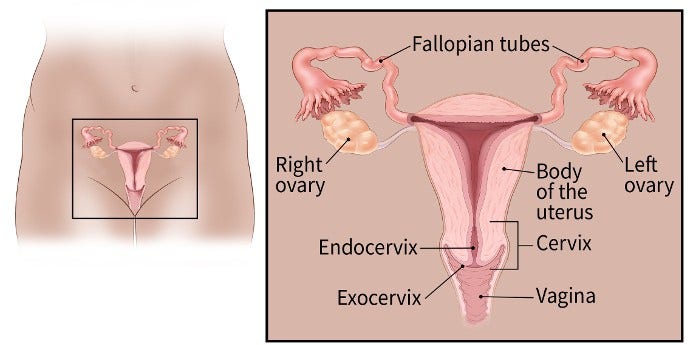What Is Cervical Cancer?
Cervical cancer starts in the cells lining the cervix – the lower part of the uterus (womb). The cervix connects the body of the uterus (the upper part where a fetus grows) to the vagina (birth canal). Cancer starts when cells in the body begin to grow out of control. To learn more about how cancers start and spread, see What Is Cancer?
The cervix is made of two parts and is covered with two different types of cells.
- The endocervix is the opening of the cervix that leads into the uterus. It is covered with glandular cells.
- The exocervix (or ectocervix) is the outer part of the cervix that can be seen by the doctor during a speculum exam. It is covered in squamous cells.
The place these two cell types meet in the cervix is called the transformation zone. The exact location of the transformation zone changes as you get older and if you give birth. Most cervical cancers begin in the cells in the transformation zone.

Abnormal changes in the cells of the cervix
Cells in the transformation zone do not suddenly change into cancer. Instead, the normal cells of the cervix first gradually develop abnormal changes that can turn into cancer. Doctors use several terms to describe these cell changes, including cervical intraepithelial neoplasia (CIN), squamous intraepithelial lesion (SIL), and dysplasia. You might hear these abnormal changes referred to as precancers or precancerous changes.
When these abnormal changes in the cervix are found, they are graded on a scale of 1 to 3 based on how much of the cervical tissue looks abnormal.
- In CIN1 (also called mild dysplasia or low grade SIL), not much of the tissue looks abnormal. Most often, these cells will change back to normal cells.
- In CIN2 or CIN3 (also called moderate/severe dysplasia or high-grade SIL) more of the tissue looks abnormal. With these cell changes, there is a higher risk that the cells can become cancer cells and will need to be watched closely or removed.
Although cervical cancers start from cells with abnormal changes, only some women with these cervix changes will develop cancer. For most women, these abnormal cells will go away without any treatment. But, in some women, these abnormal cells can turn into true (invasive) cancers. Treating abnormal changes in cervical cells can prevent almost all cervical cancers.
Cervical cancer screening looks for abnormal cells in the cervix or cervical cancer early, when treatment is more likely to be successful. Regular screening can prevent cervical cancer and save lives.
The HPV test and the Pap test are used to screen for cervical cancer:
- The Pap test can detect and treat precancerous changes to prevent cancer from developing.
- The HPV test looks for infection by high-risk types of HPV that are more likely to cause precancers and cancers of the cervix. There is no treatment for HPV infection, but a vaccine can help prevent it.
See Can Cervical Cancer Be Prevented? The specific types of treatment for abnormal screening tests are discussed in When Cervical Screening Test Results are Abnormal.
Types of cervical cancer
Cervical cancers and cervical precancers are classified by how they look in the lab under a microscope. The main types of cervical cancers are squamous cell carcinoma and adenocarcinoma.
- Most (up to 9 out of 10) cervical cancers are squamous cell carcinomas. These cancers develop from cells in the exocervix. Squamous cell carcinomas most often begin in the transformation zone (where the exocervix joins the endocervix).
- Most other cervical cancers are adenocarcinomas. Adenocarcinomas are cancers that develop from glandular cells. Cervical adenocarcinoma develops from the mucus-producing gland cells of the endocervix.
- Less commonly, cervical cancers have features of both squamous cell carcinomas and adenocarcinomas. These are called adenosquamous carcinomas or mixed carcinomas.
Although almost all cervical cancers are either squamous cell carcinomas or adenocarcinomas, other types of cancer also can develop in the cervix. These other types, such as melanoma, sarcoma, and lymphoma, occur more commonly in other parts of the body.
Only the more common cervical cancer types are covered here.
- Written by
- References

Developed by the American Cancer Society medical and editorial content team with medical review and contribution by the American Society of Clinical Oncology (ASCO).
Eifel P, Klopp AH, Berek JS, and Konstantinopoulos A. Chapter 74: Cancer of the Cervix, Vagina, and Vulva. In: DeVita VT, Lawrence TS, Rosenberg SA, eds. DeVita, Hellman, and Rosenberg’s Cancer: Principles and Practice of Oncology. 11th ed. Philadelphia, Pa: Lippincott Williams & Wilkins; 2019.
Fontham, ETH, Wolf, AMD, Church, TR, et al. Cervical Cancer Screening for Individuals at Average Risk: 2020 Guideline Update from the American Cancer Society. CA Cancer J Clin. 2020. https://doi.org/10.3322/caac.21628.
Jhungran A, Russell AH, Seiden MV, Duska LR, Goodman A, Lee S, et al. Chapter 84: Cancers of the Cervix, Vulva, and Vagina. In: Niederhuber JE, Armitage JO, Doroshow JH, Kastan MB, Tepper JE, eds. Abeloff’s Clinical Oncology. 6th ed. Philadelphia, Pa: Elsevier; 2020.
Khieu M, Butler SL. High Grade Squamous Intraepithelial Lesion. StatPearls. PMID: 28613479. 2022.
National Cancer Institute. Physician Data Query (PDQ). Cervical Cancer Treatment – Health Professional Version. 2019. https://www.cancer.gov/types/cervical/hp/cervical-treatment-pdq. Updated February 6, 2019. Accessed on October 30, 2019.
Last Revised: July 1, 2025
American Cancer Society medical information is copyrighted material. For reprint requests, please see our Content Usage Policy.
American Cancer Society Emails
Sign up to stay up-to-date with news, valuable information, and ways to get involved with the American Cancer Society.


